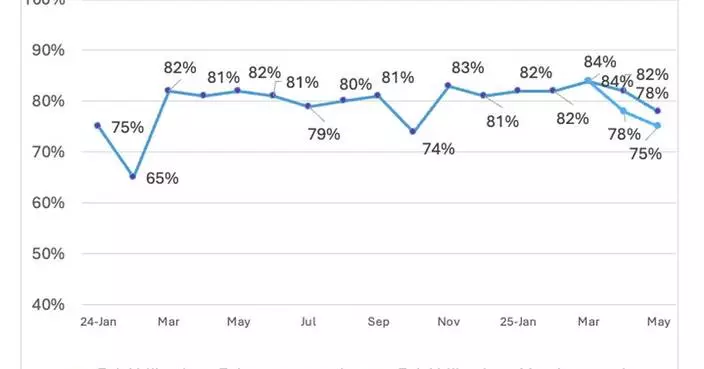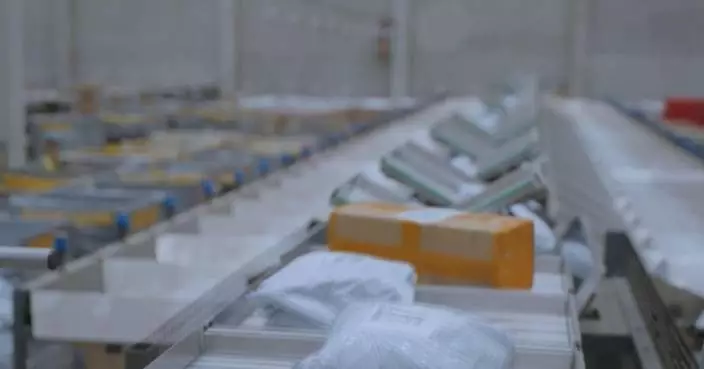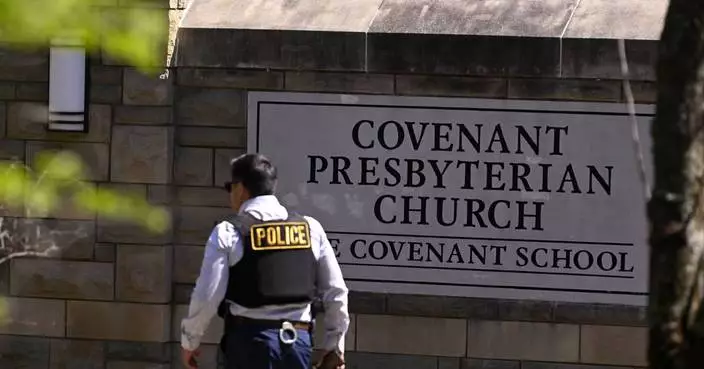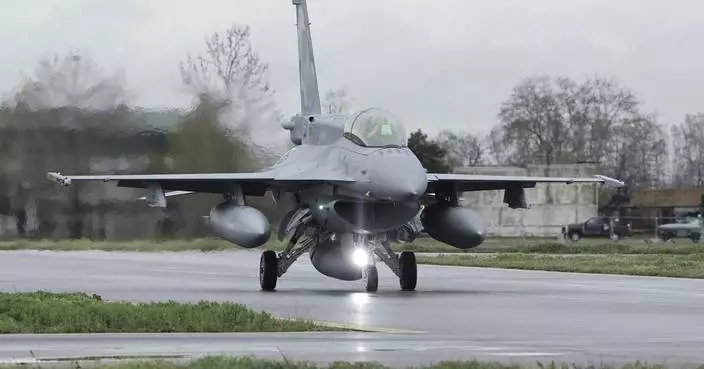ORONO, Maine (AP) — The world’s largest 3D printer has created a house that can cut construction time and labor. An even larger printer unveiled on Tuesday may one day create entire neighborhoods.
The machine revealed Tuesday at the University of Maine is four times larger than the first one — commissioned less than five years ago — and capable of printing ever mightier objects. That includes scaling up its 3D-printed home technology using bio-based materials to eventually demonstrate how printed neighborhoods can offer an avenue to affordable housing to address homelessness in the region.
Click to Gallery
Habib Dasher, director of UMaine's Advanced Structures & Composite Center, speaks at the unveiling of the world's largest 3D printer, Tuesday, April 23, 2024, at the University of Maine, in Orono, Maine. (AP Photo/Robert F. Bukaty)
The BioHome3D is seen Tuesday, April 23, 2024, at the University of Maine, in Orono, Maine. The 600-square-foot single-family home was made by UMaine's original 3D printer in 2019. (AP Photo/Robert F. Bukaty)
The world's largest 3D printer is seen Tuesday, April 23, 2024, at the University of Maine, in Orono, Maine. (AP Photo/Robert F. Bukaty)
The world's largest 3D printer is seen Tuesday, April 23, 2024, at the University of Maine, in Orono, Maine. (AP Photo/Robert F. Bukaty)
The University of Maine's first 3D printed home sits on Oct. 12, 2023, in Orono, Maine. The printer that created the house can cut construction time and labor. An even larger printer unveiled on Tuesday, April 23, 2024, may one day create entire neighborhoods. (AP Photo/Kevin Bennett)
A cross section of an exterior wall of a house is being printed on a 3D printer at the University of Maine's Advanced Structures & Composite Center on Oct. 12, 2023, in Orono, Maine. An even larger printer unveiled on Tuesday, April 23, 2024, may one day create entire neighborhoods. (AP Photo/Kevin Bennett)
A bed sits inside the University of Maine's first 3D printed home on Oct. 12, 2023, in Orono, Maine. The printer that created the house can cut construction time and labor. An even larger printer unveiled on Tuesday, April 23, 2024, may one day create entire neighborhoods. (AP Photo/Kevin Bennett)
The inside of the University of Maine's first 3D printed home is visible on Oct. 12, 2023, in Orono, Maine. The printer that created the house can cut construction time and labor. An even larger printer unveiled on Tuesday, April 23, 2024, may one day create entire neighborhoods. (AP Photo/Kevin Bennett)
Thermoplastic polymers are extruded from a printer dubbed the “Factory of the Future 1.0." There could be even larger printers after the University of Maine breaks ground this summer on a new building, a spokesperson said.
The massive printer “opens up new research frontiers to integrate these collaborative robotics operations at a very large scale with new sensors, high-performance computing and artificial intelligence,” said Habib Dagher, director of UMaine’s Advanced Structures & Composite Center, where both of the printers are located.
Those attending the event included representatives from departments of defense, energy and housing, as well as other stakeholders who plan to utilize the new technologies made available by the printer. Heidi Shyu, under secretary of defense for research and engineering, said the printer "stands as a beacon of innovation."
The printer's frame fills up the large building in which it’s housed on the UMaine campus, and can print objects 96 feet long by 32 feet wide by 18 feet high (29 meters by 10 meters by 5.5 meters).
It has a voracious appetite, consuming as much as 500 pounds (227 kilograms) of material per hour.
The original printer, christened in 2019, was certified by Guinness World Records as the world’s largest polymer 3D printer, the university said. It was used to create a 600-square-foot, single-family home made of wood fiber and bio-resin materials that are recyclable. Dubbed “BioHome3D," it showed an ability to quickly produce homes. To meet the growing demand for housing, Maine alone will need another 80,000 homes over the next six years, according to MaineHousing.
Dagher said there's a shortage of both affordable housing and workers to build homes. The university wants to show how homes can be constructed nearly entirely by a printer with a lower carbon footprint. The buildings and construction sector accounts for roughly 37% of global greenhouse gas emissions, largely due to the production and use of materials such as cement, steel and aluminum that have a significant carbon footprint, according to the United Nations Environment Programme.
Such printed buildings can be recycled, which is unique compared to current construction. “You can basically deconstruct it, you can grind it up if you wish, the 3D printed parts, and reprint with them, do it again,” Dagher said before the event.
“It’s not about building a cheap house or a biohome,” he added, referring to the first 3D-printed house made entirely with bio-based materials. “We wanted to build a house that people would say, ‘Wow, I really want to live there.’”
Looking ahead, researchers plan to tinker with the material consumed by the machine, including more bio-based feedstocks from wood residuals that are abundant in Maine, the nation’s most heavily forested state.
But it can be used for a variety of other creations and already has been used for a range of things, from boats to defense department structures. In the past, the university showed off a 25-foot boat created by the first printer.
As for the original 3D printer, it isn't going away. The two printers can be used in concert to streamline manufacturing by working on the same project — or even part if necessary — and there will be even more of them working together in the future, officials said.
McDermott reported from Providence, Rhode Island.

Habib Dasher, director of UMaine's Advanced Structures & Composite Center, speaks at the unveiling of the world's largest 3D printer, Tuesday, April 23, 2024, at the University of Maine, in Orono, Maine. (AP Photo/Robert F. Bukaty)
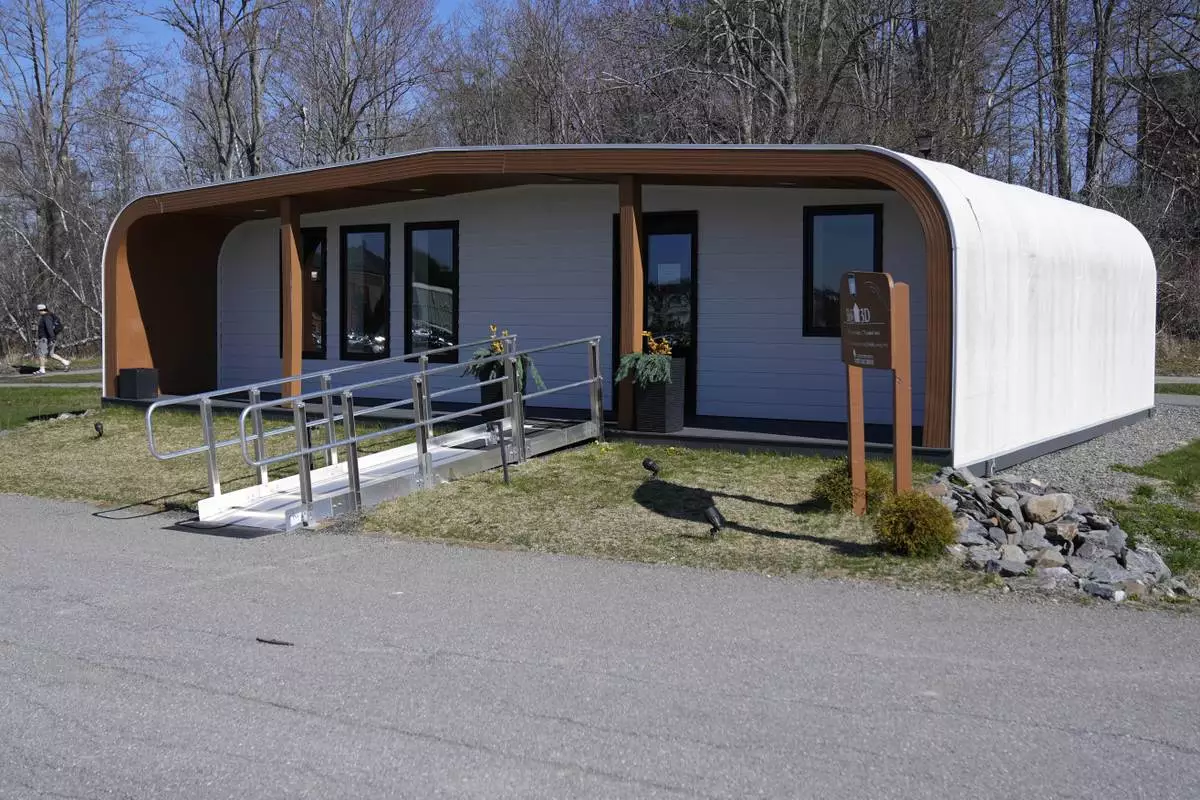
The BioHome3D is seen Tuesday, April 23, 2024, at the University of Maine, in Orono, Maine. The 600-square-foot single-family home was made by UMaine's original 3D printer in 2019. (AP Photo/Robert F. Bukaty)
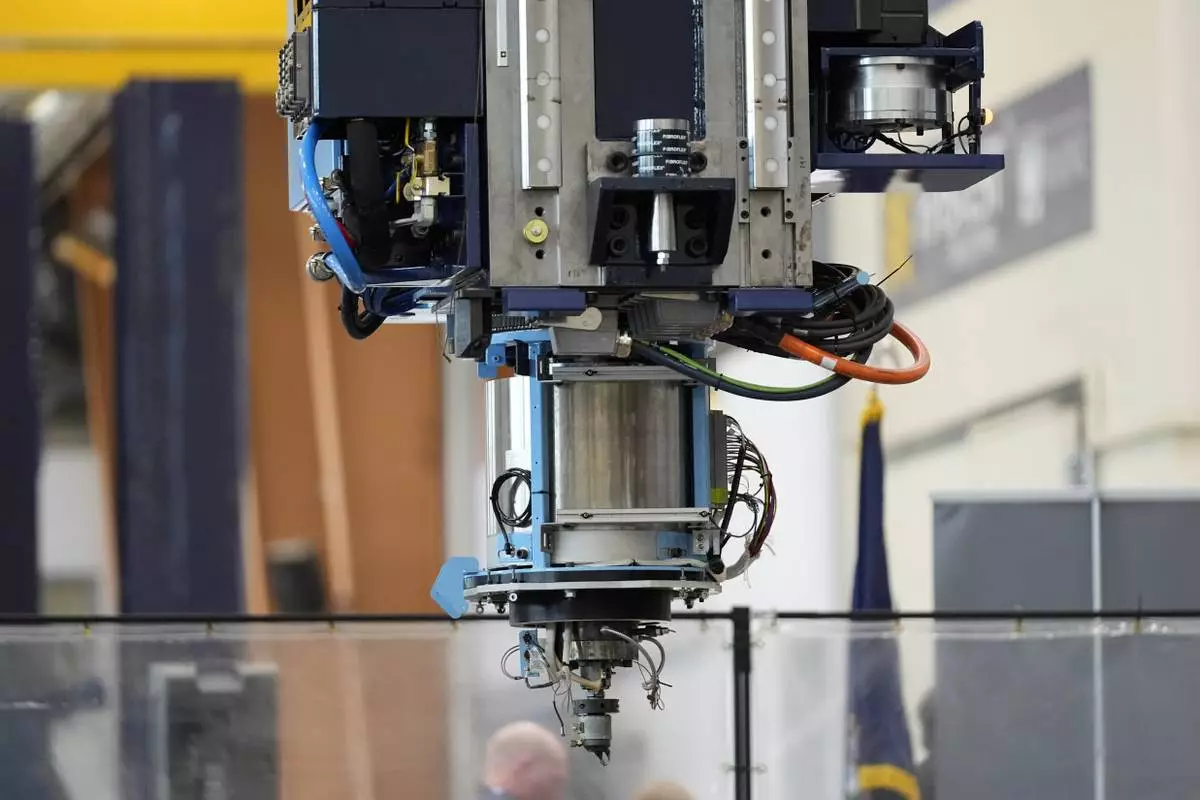
The world's largest 3D printer is seen Tuesday, April 23, 2024, at the University of Maine, in Orono, Maine. (AP Photo/Robert F. Bukaty)
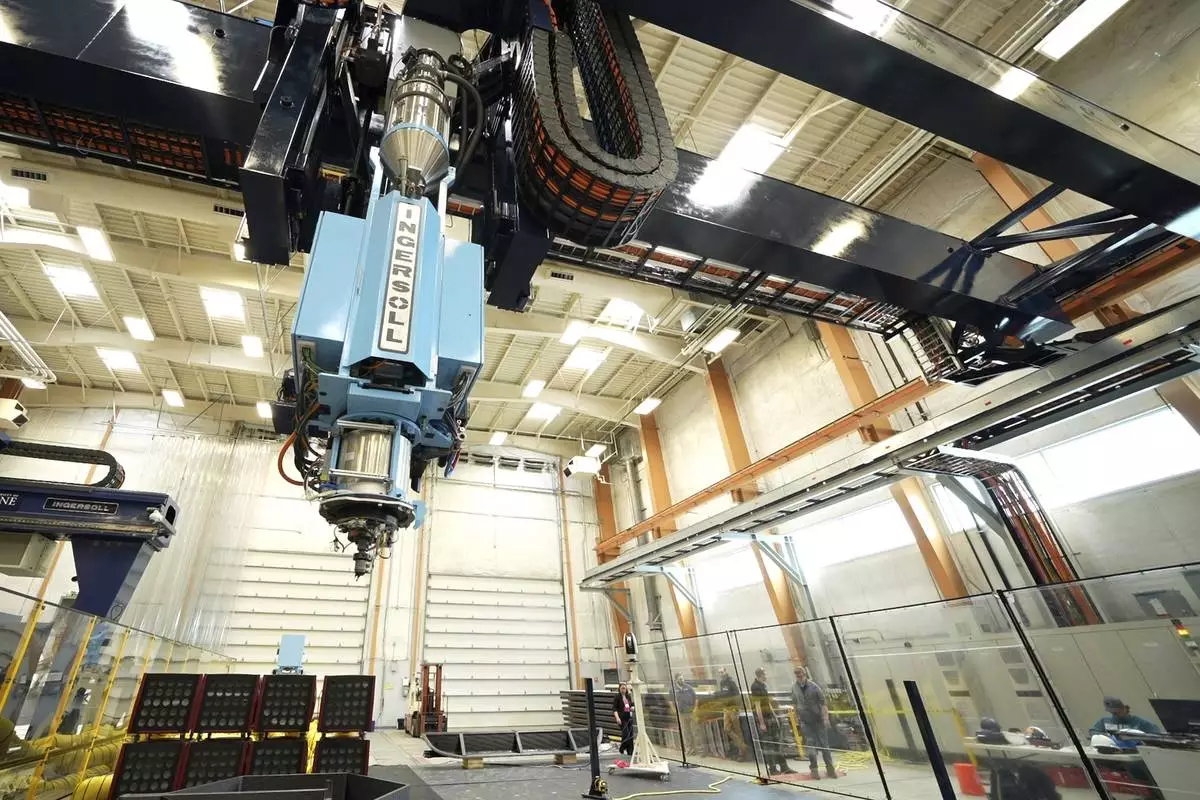
The world's largest 3D printer is seen Tuesday, April 23, 2024, at the University of Maine, in Orono, Maine. (AP Photo/Robert F. Bukaty)
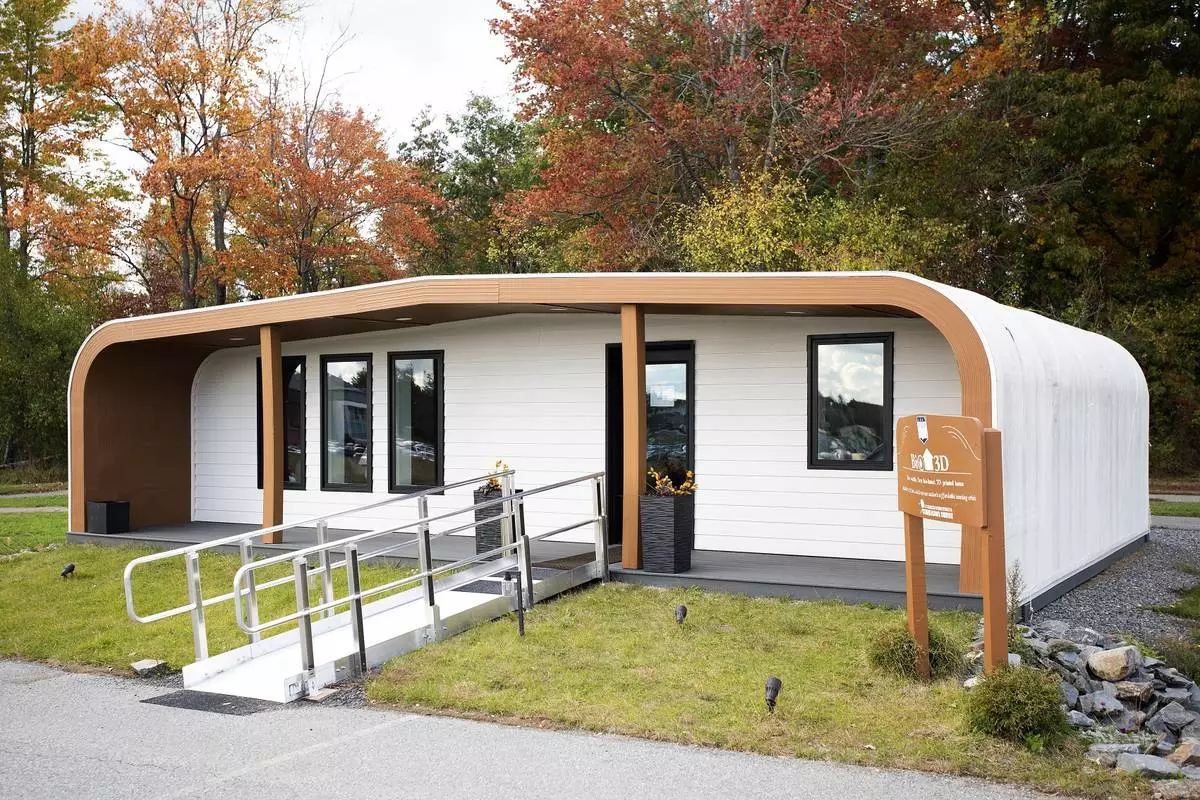
The University of Maine's first 3D printed home sits on Oct. 12, 2023, in Orono, Maine. The printer that created the house can cut construction time and labor. An even larger printer unveiled on Tuesday, April 23, 2024, may one day create entire neighborhoods. (AP Photo/Kevin Bennett)
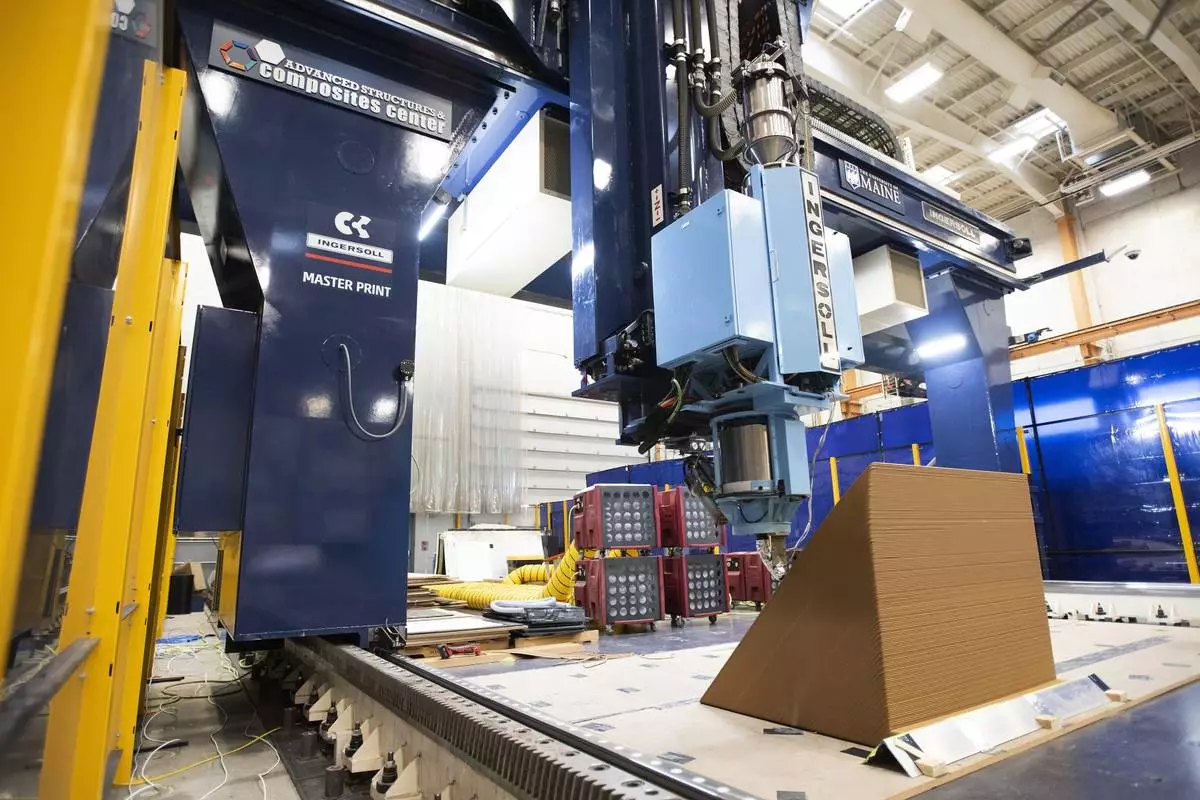
A cross section of an exterior wall of a house is being printed on a 3D printer at the University of Maine's Advanced Structures & Composite Center on Oct. 12, 2023, in Orono, Maine. An even larger printer unveiled on Tuesday, April 23, 2024, may one day create entire neighborhoods. (AP Photo/Kevin Bennett)

A bed sits inside the University of Maine's first 3D printed home on Oct. 12, 2023, in Orono, Maine. The printer that created the house can cut construction time and labor. An even larger printer unveiled on Tuesday, April 23, 2024, may one day create entire neighborhoods. (AP Photo/Kevin Bennett)

The inside of the University of Maine's first 3D printed home is visible on Oct. 12, 2023, in Orono, Maine. The printer that created the house can cut construction time and labor. An even larger printer unveiled on Tuesday, April 23, 2024, may one day create entire neighborhoods. (AP Photo/Kevin Bennett)
DEIR AL BALAH, Gaza Strip (AP) — Overnight strikes by Israel killed at least 55 people across the Gaza Strip, hospital officials said Thursday, a day after senior government officials said Israel would seize large areas of Gaza and establish a new security corridor across the Palestinian territory.
Israel has vowed to escalate the nearly 18-month war with Hamas until the militant group returns dozens of remaining hostages, disarms and leaves the territory. Israel has imposed a month-long halt on all imports of food, fuel and humanitarian aid that has left civilians facing acute shortages as supplies dwindle.
Officials in Khan Younis, in the southern part of the strip, said the bodies of 14 people had been taken to Nasser Hospital – nine of them from the same family. The dead included five children and four women. The bodies of another 19 people, including five children aged between 1 and 7 years and a pregnant woman, were taken to the European hospital near Khan Younis, hospital officials said. In Gaza City, 21 bodies were taken to Ahli hospital, including those of seven children.
The Israeli military ordered the residents of several areas -- Shujaiya, Jadida, Turkomen and eastern Zeytoun -- to evacuate on Thursday, adding that the army “will work with extreme force in your area.” It said people should move to shelters west of Gaza City.
On Wednesday, Prime Minister Benjamin Netanyahu announced Israel was establishing a new security corridor across the Gaza Strip to pressure Hamas, suggesting it would cut off the southern city of Rafah, which Israel has ordered evacuated, from the rest of the Palestinian territory.
Netanyahu referred to the new axis as the Morag corridor, using the name of a Jewish settlement that once stood between Rafah and Khan Younis, suggesting it would run between the two southern cities. He said it would be “a second Philadelphi corridor ” referring to the Gaza side of the border with Egypt further south, which has been under Israeli control since last May.
Israel has reasserted control over the Netzarim corridor, also named for a former settlement, that cuts off the northern third of Gaza, including Gaza City, from the rest of the narrow coastal strip. Both of the existing corridors run from the Israeli border to the Mediterranean Sea.
“We are cutting up the strip, and we are increasing the pressure step by step, so that they will give us our hostages,” Netanyahu said.
The Western-backed Palestinian Authority, led by rivals of Hamas, expressed its “complete rejection” of the planned corridor. Its statement also called for Hamas to give up power in Gaza, where the militant group has faced rare protests recently.
Netanyahu’s announcement came after the defense minister, Israel Katz, said Israel would seize large areas of Gaza and add them to its so-called security zones, apparently referring to an existing buffer zone along Gaza’s entire perimeter. He called on Gaza residents to “expel Hamas and return all the hostages,” saying “this is the only way to end the war.”
Hamas has said it will only release the remaining 59 hostages — 24 of whom are believed to be alive — in exchange for the release of more Palestinian prisoners, a lasting ceasefire and an Israeli pullout. The group has rejected demands that it lay down its arms or leave the territory.
Netanyahu arrived in Hungary early Thursday on his second foreign trip since the world's top war crimes court issued an arrest warrant against him in November over Israel's war in Gaza.
Based in The Hague, Netherlands, the the International Criminal Court has said there was reason to believe Netanyahu and former Israeli Defense Minister Yoav Gallant used “starvation as a method of warfare” by restricting humanitarian aid to the Gaza Strip, and intentionally targeted civilians in Israel’s campaign against Hamas — charges that Israeli officials deny.
ICC member countries, such as Hungary, are required to arrest suspects facing a warrant if they set foot on their soil, but the court has no way to enforce that and relies on states to comply. As Netanyahu arrived in Budapest, Hungary said it will begin the procedure of withdrawing from the ICC.
On Sunday, Netanyahu said Israel plans to maintain overall security control of Gaza after the war and implement U.S. President Donald Trump’s proposal to resettle much of its population elsewhere through what the Israeli leader referred to as “voluntary emigration.”
Palestinians have rejected the plan, viewing it as expulsion from their homeland after Israel’s offensive left much of it uninhabitable, and human rights experts say implementing the plan would likely violate international law.
The war began when Hamas-led militants attacked southern Israel on Oct. 7, 2023, killing around 1,200 people, mostly civilians, and taking 251 hostages, most of whom have since been released in ceasefire agreements and other deals. Israel rescued eight living hostages and has recovered dozens of bodies.
Israel’s offensive has killed more than 50,000 Palestinians, according to Gaza’s Health Ministry, which doesn’t say whether those killed are civilians or combatants. Israel says it has killed around 20,000 militants, without providing evidence.
The war has left vast areas of Gaza in ruins and at its height displaced around 90% of the population.
Separately, Israeli strikes killed at least nine people in southwestern Syria, Syrian state media reported Thursday.
SANA said the nine were civilians, without giving details. Britain-based war monitor The Syrian Observatory for Human Rights said they were local gunmen from the Daraa province, frustrated with Israeli military encroachment and attacks in recent months.
Israel has seized parts of southwestern Syria and created a buffer-zone there, which it says is to secure Israel’s safety from armed groups. But critics say the military operation has created tensions in Syria and prevents any long-term stability and reconstruction for the war-torn country.
Israel also struck five cities in Syria late Wednesday, including over a dozen strikes near a strategic airbase in the city of Hama.
Follow AP’s war coverage at https://apnews.com/hub/israel-hamas-war
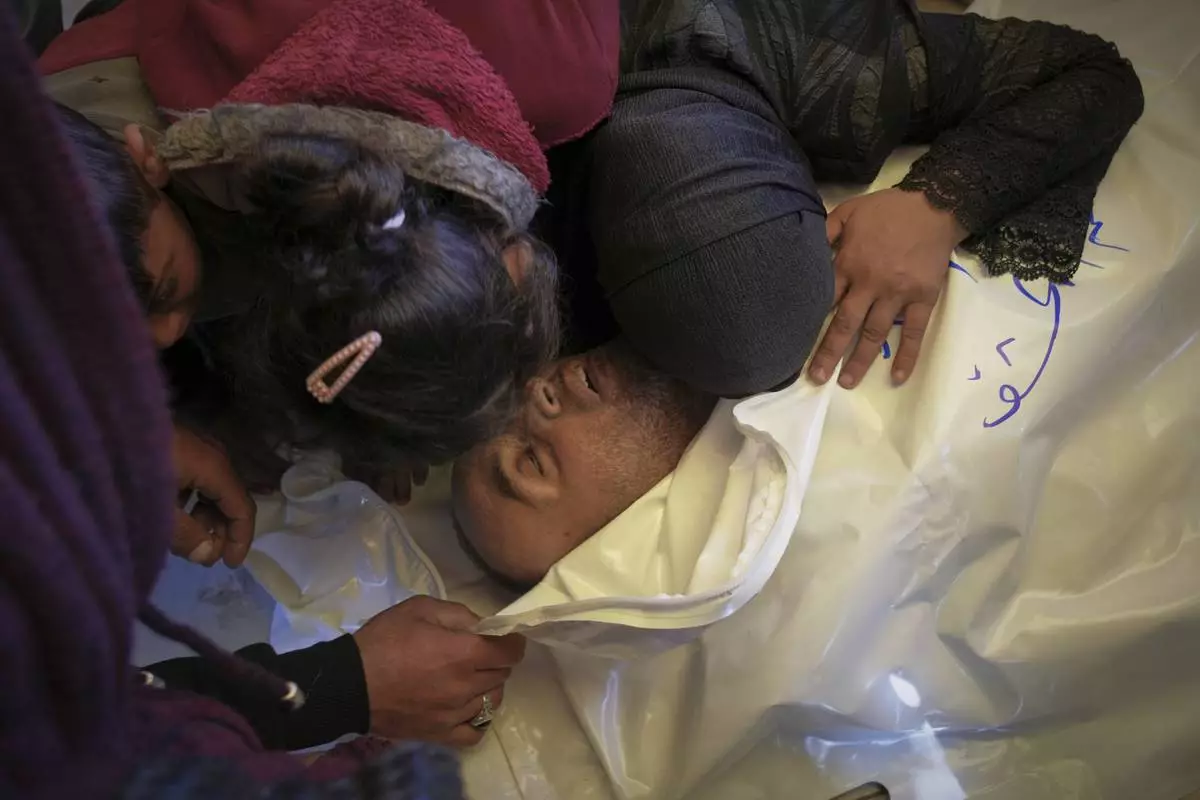
Relatives mourn the body of Ashraf Al Aqqad, who was killed in an Israeli army strike, before his burial at the hospital in Khan Younis, southern Gaza Strip, Thursday, April 3, 2025. (AP Photo/Abdel Kareem Hana)

Relatives of Ayad Jundia who was killed in an Israeli airstrike, grieve over his body at the Baptist Hospital in Gaza City, on Thursday, April 3, 2025. (AP Photo/Jehad Alshrafi)
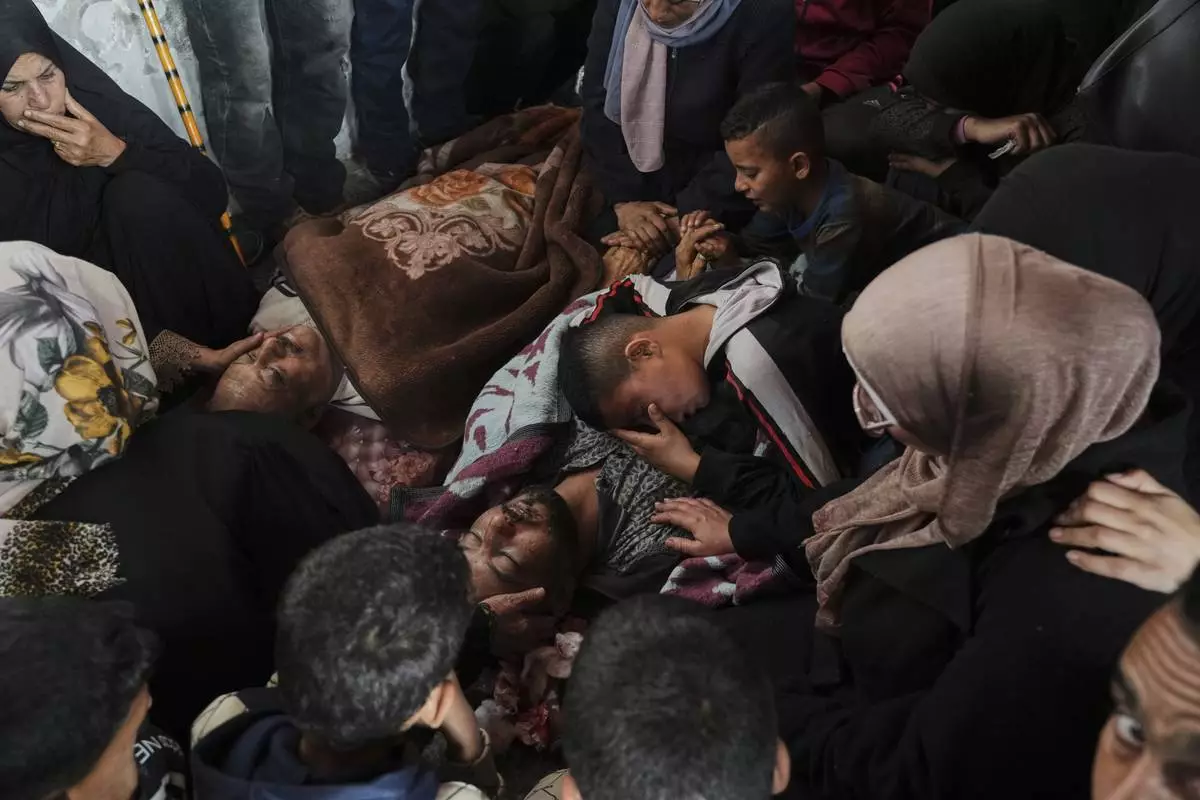
Palestinians grieve over the bodies of their relatives, who were killed in an Israeli airstrike, as they brought to the Baptist Hospital in Gaza City, on Thursday, April 3, 2025. (AP Photo/Jehad Alshrafi)
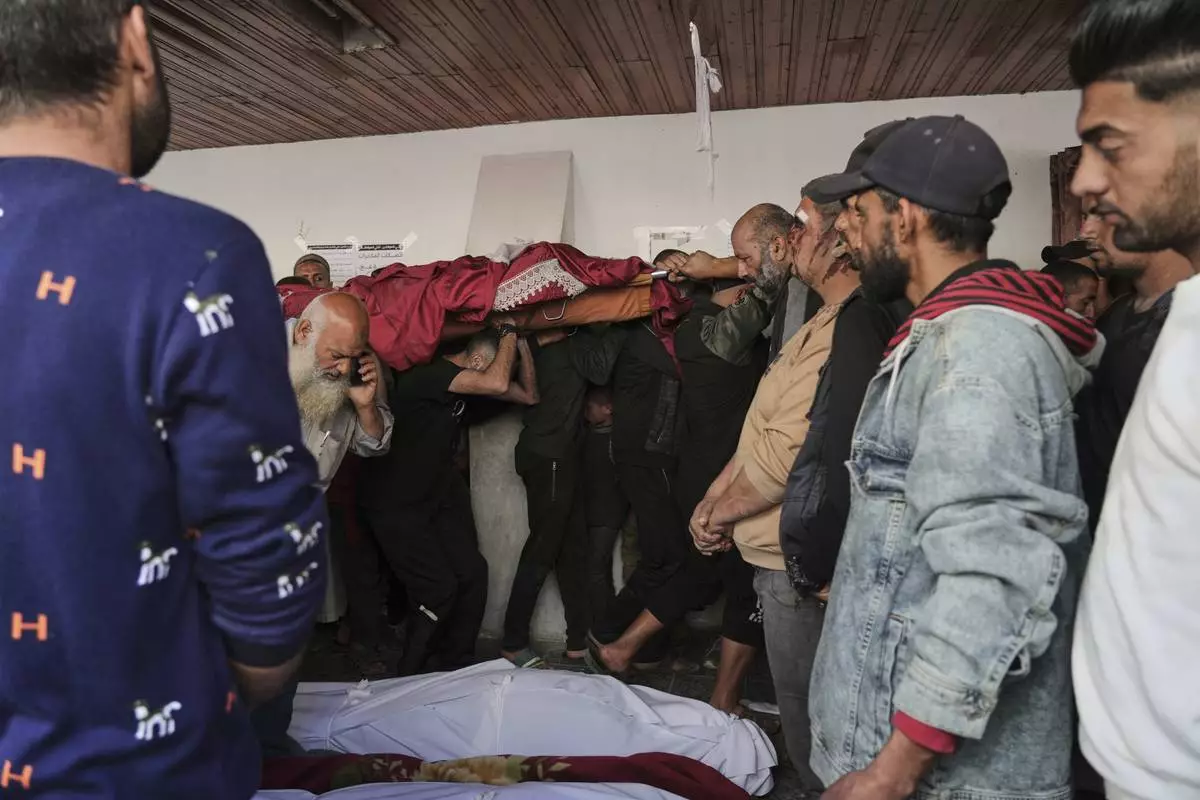
Palestinians carry the bodies of those who were killed in an Israeli airstrike, as they brought to the Baptist Hospital in Gaza City, on Thursday, April 3, 2025. (AP Photo/Jehad Alshrafi)
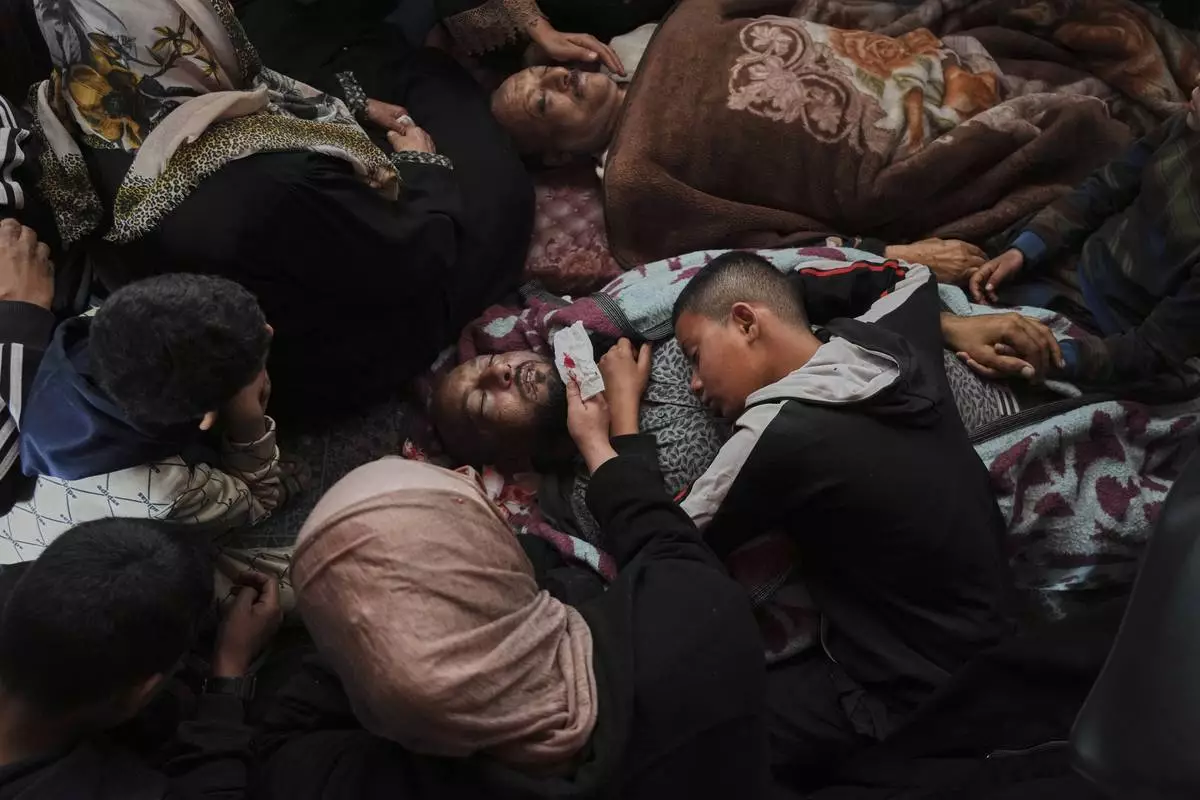
Palestinians grieve over the bodies of their relatives, who were killed in an Israeli airstrike, as they brought to the Baptist Hospital in Gaza City, on Thursday, April 3, 2025. (AP Photo/Jehad Alshrafi)
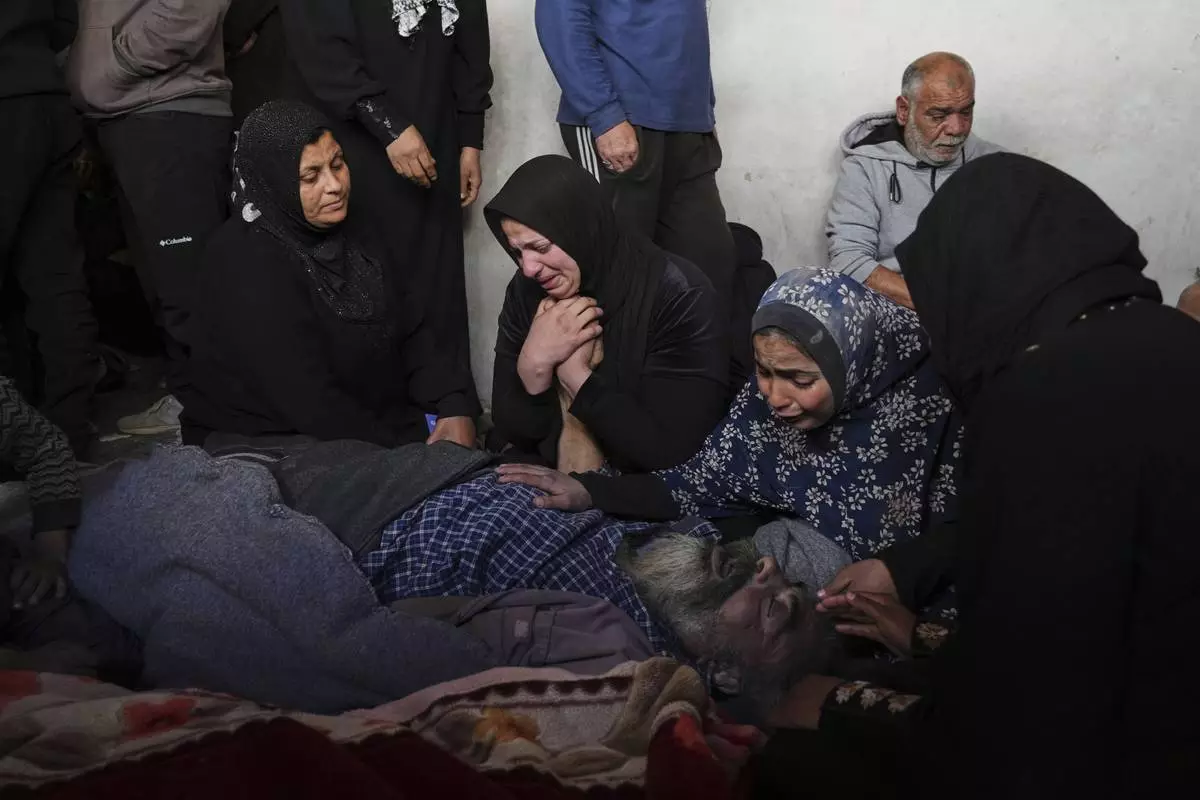
Relatives of Ayad Jundia who was killed in an Israeli airstrike, grieve over his body at the Baptist Hospital in Gaza City, on Thursday, April 3, 2025. (AP Photo/Jehad Alshrafi)
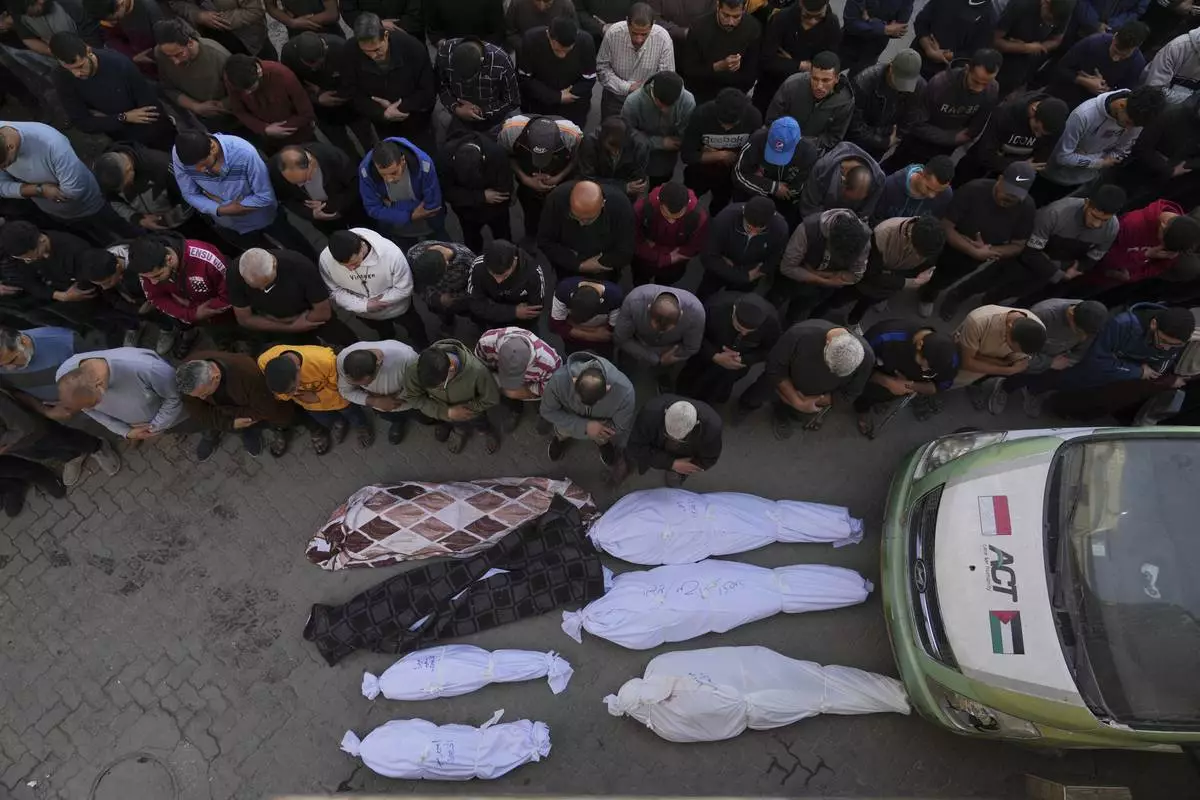
Palestinians pray over the bodies of their relatives, who were killed in an Israeli airstrike, at the Baptist Hospital in Gaza City, on Thursday, April 3, 2025. (AP Photo/Jehad Alshrafi)
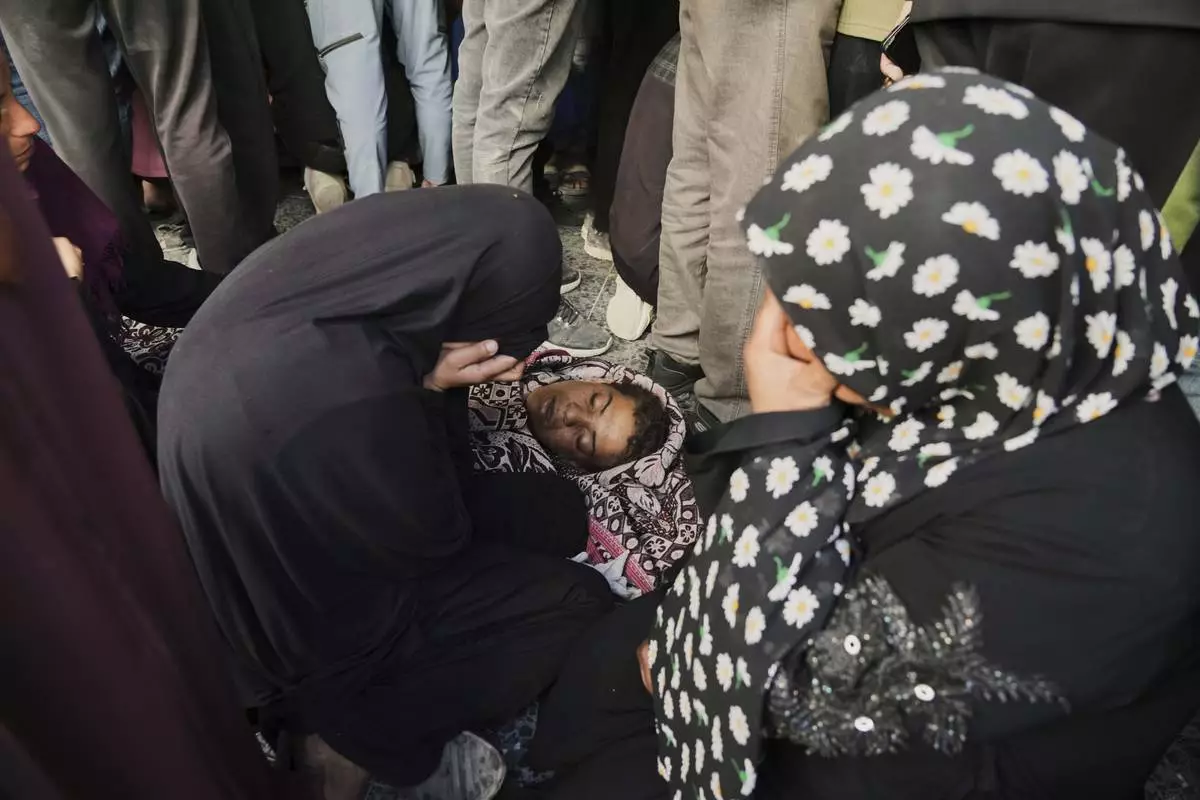
Palestinians grieve over the bodies of their relatives, who were killed in an Israeli airstrike, as they brought to the Baptist Hospital in Gaza City, on Thursday, April 3, 2025. (AP Photo/Jehad Alshrafi)
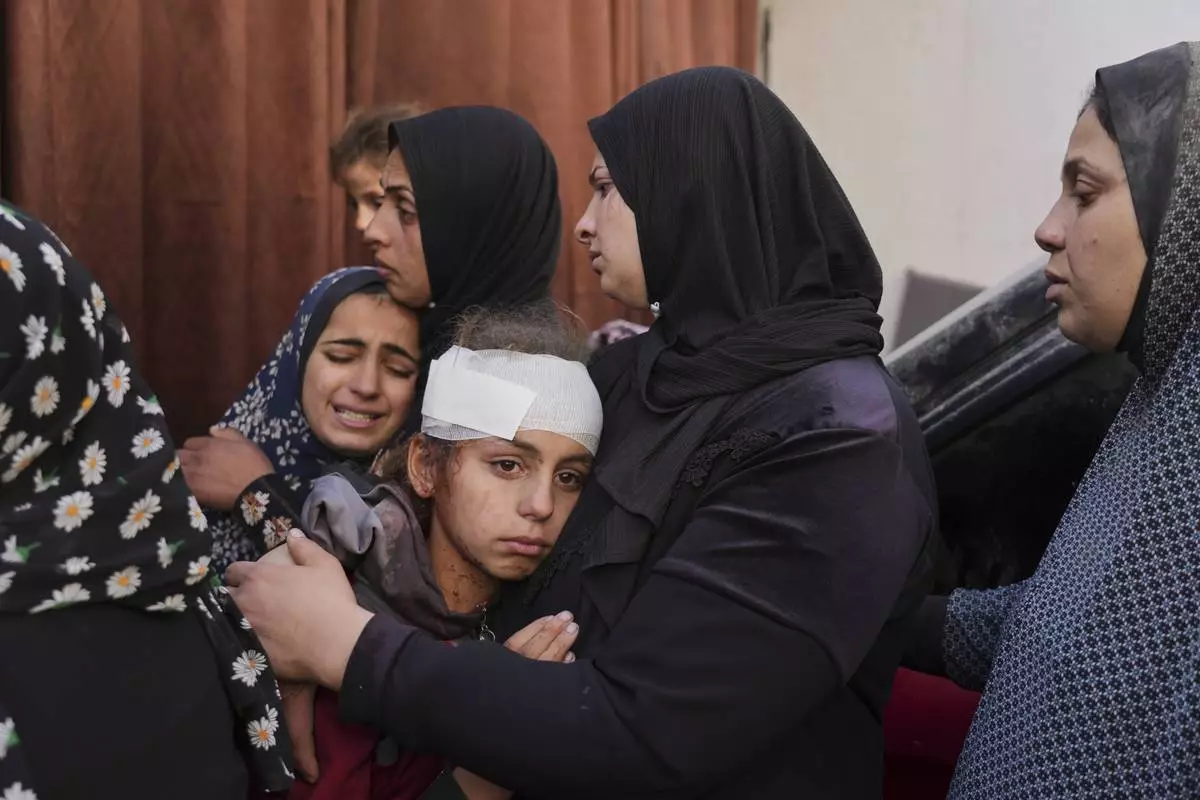
Yamama Jundia, 13, injured in an Israeli airstrike, grieves alongside others over the bodies of their relatives, who were killed in the same strike, at the Baptist Hospital in Gaza City on Thursday, April 3, 2025. (AP Photo/Jehad Alshrafi)
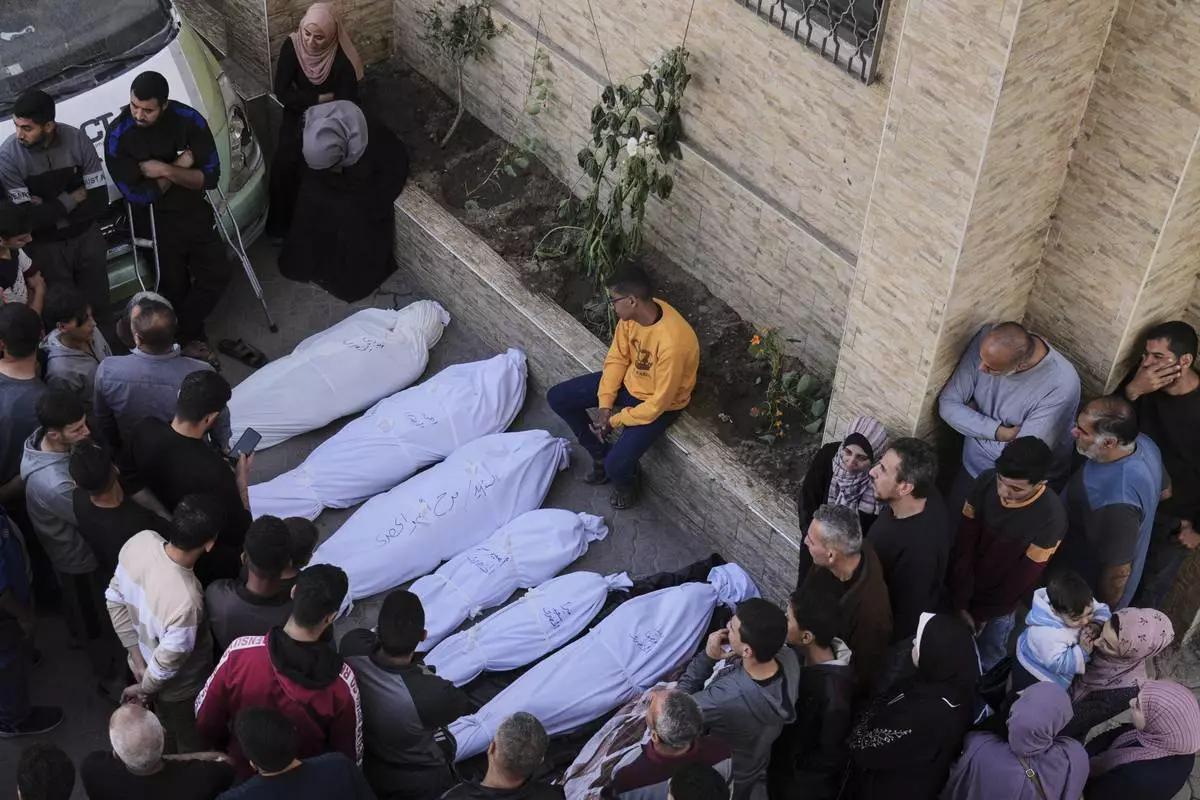
Palestinians grieve over the bodies of their relatives, who were killed in an Israeli airstrike, at the Baptist Hospital in Gaza City, on Thursday, April 3, 2025. (AP Photo/Jehad Alshrafi)
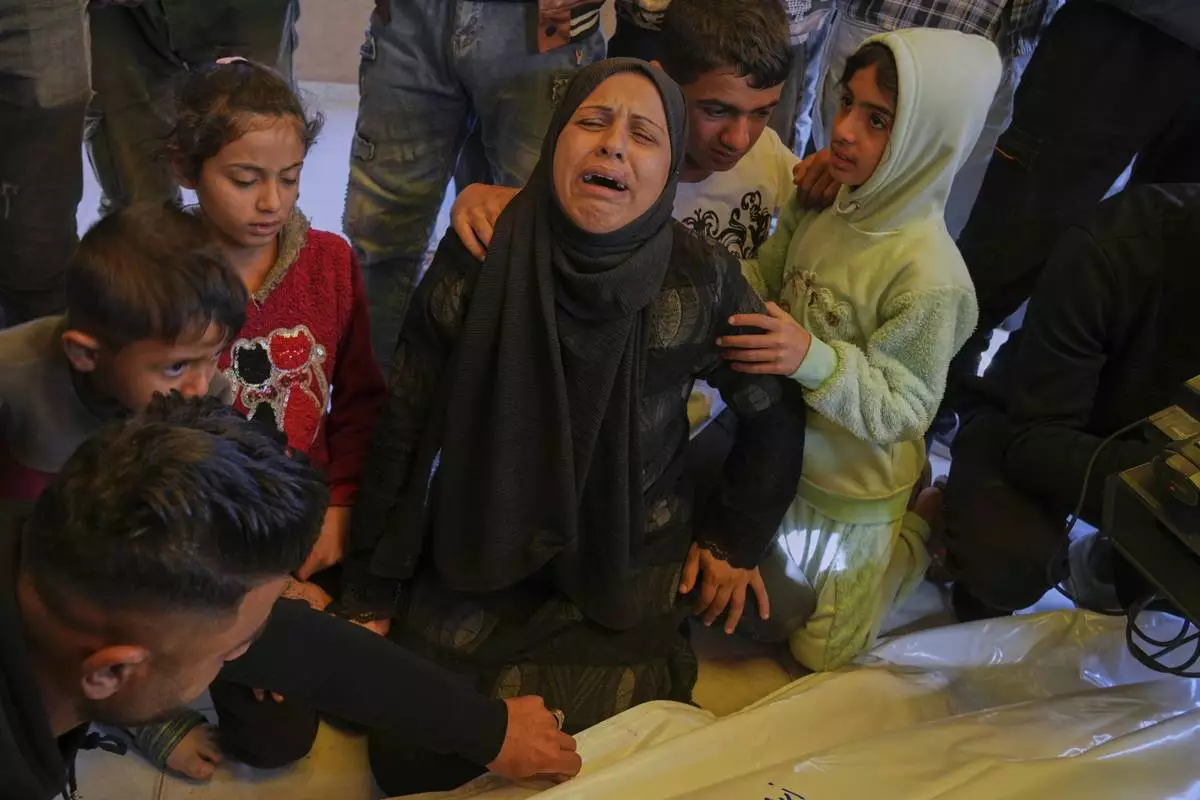
Inas Al Aqqad mourns the body of her husband Ashraf, who was killed in an Israeli army strike, before his burial at the hospital in Khan Younis, southern Gaza Strip, Thursday, April 3, 2025. (AP Photo/Abdel Kareem Hana)
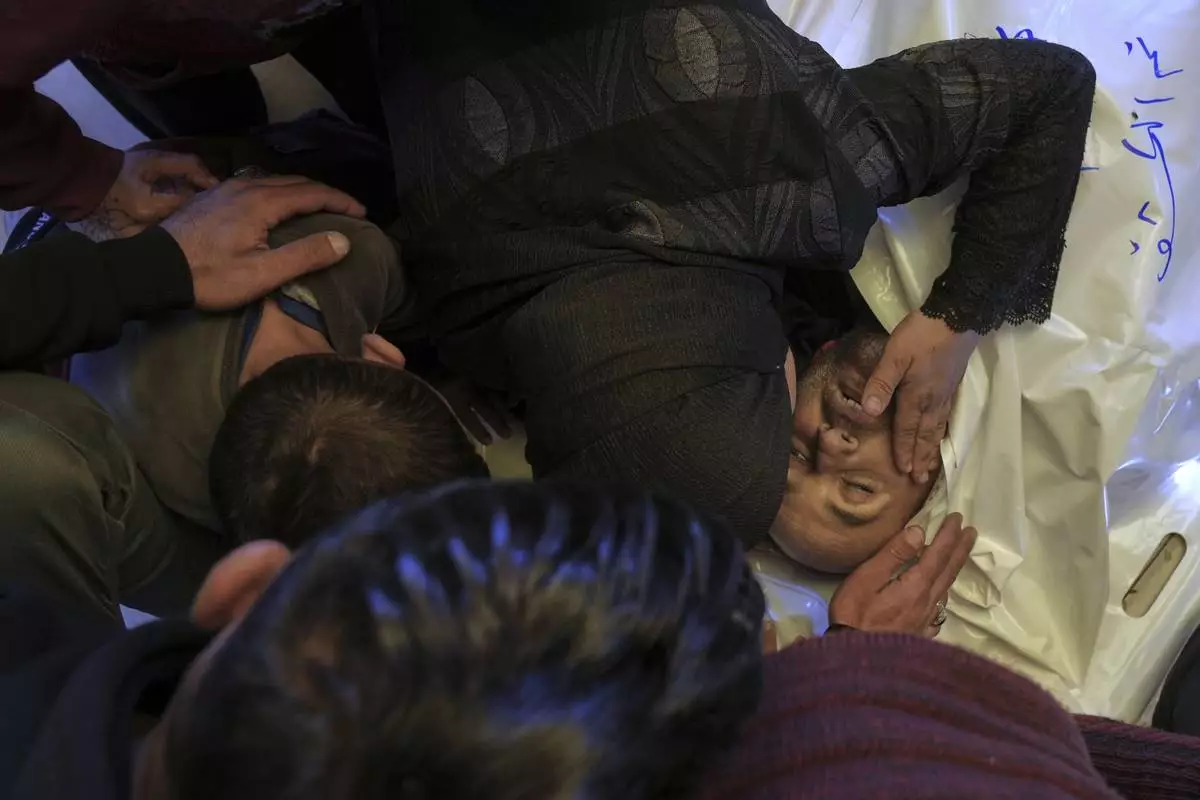
Relatives mourn the body of Ashraf Al Aqqad, who was killed in an Israeli army strike, before his burial at the hospital in Khan Younis, southern Gaza Strip, Thursday, April 3, 2025. (AP Photo/Abdel Kareem Hana)
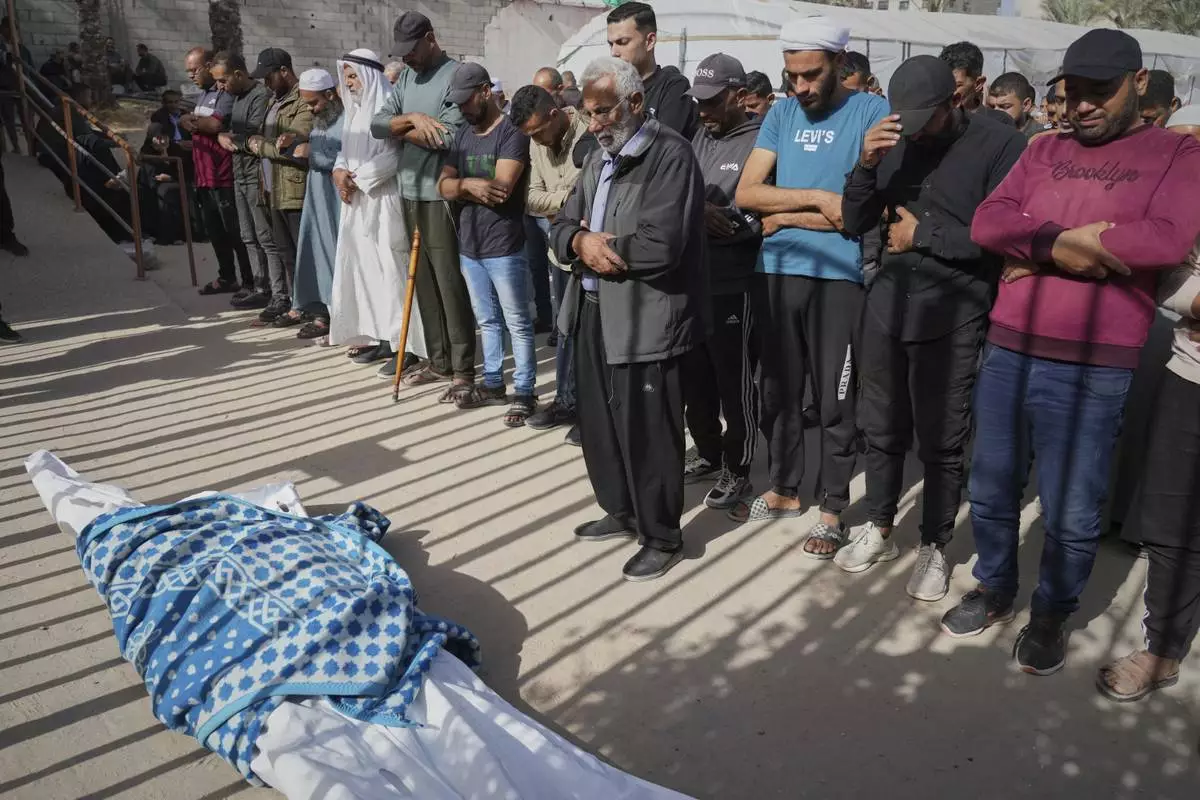
Mourners pray over the body of a woman killed in an Israeli army strike, before her burial at the hospital in Khan Younis, southern Gaza Strip, Thursday, April 3, 2025. (AP Photo/Abdel Kareem Hana)
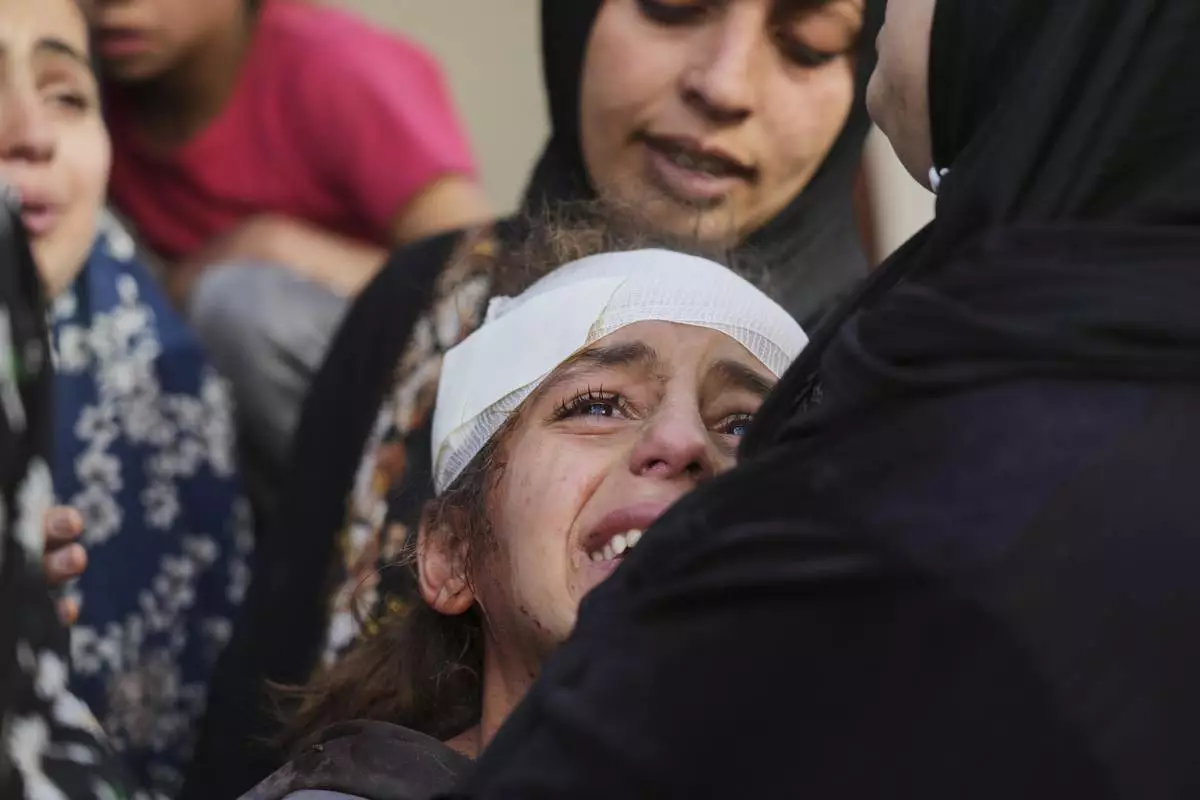
Yamama Jundia, 13, injured in an Israeli airstrike, grieves alongside others over the bodies of their relatives, who were killed in the same strike, at the Baptist Hospital in Gaza City on Thursday, April 3, 2025. (AP Photo/Jehad Alshrafi)
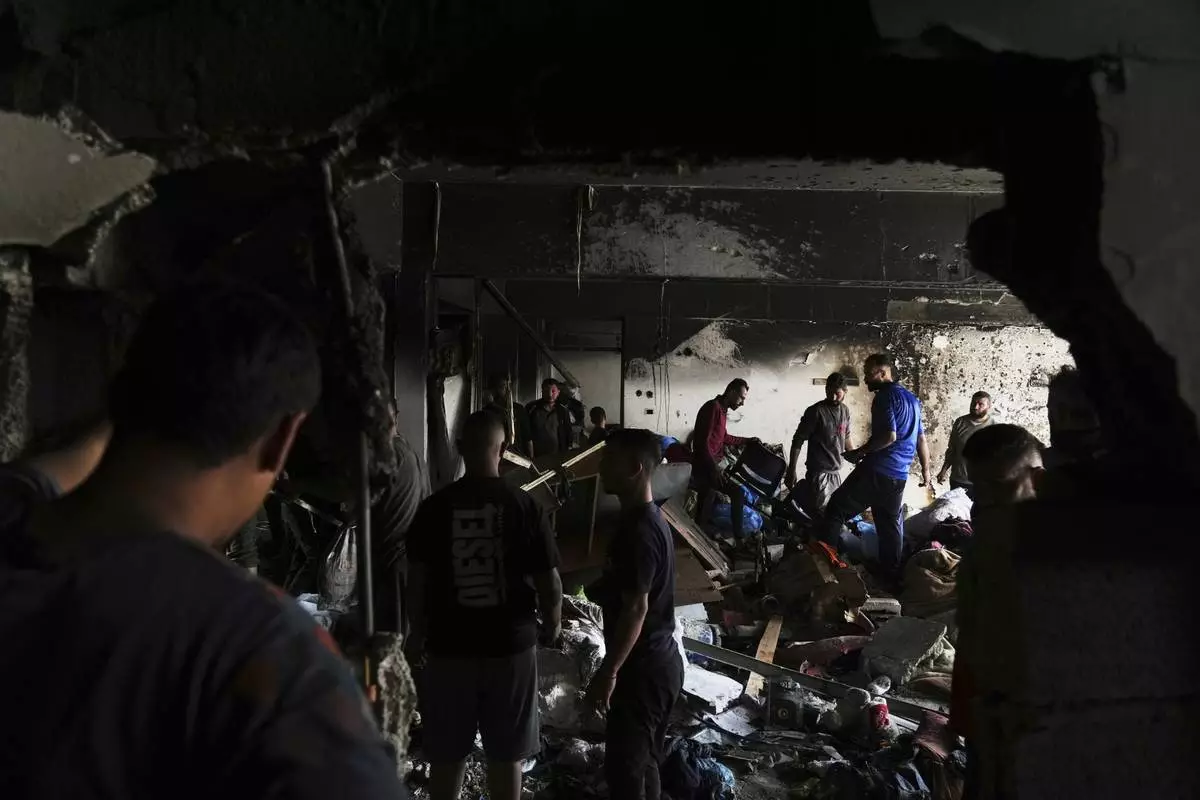
Palestinians inspect a UN building after it was hit by an Israeli strike, in Jabaliya, northern Gaza Strip on Wednesday, April 2, 2025. (AP Photo/Jehad Alshrafi)
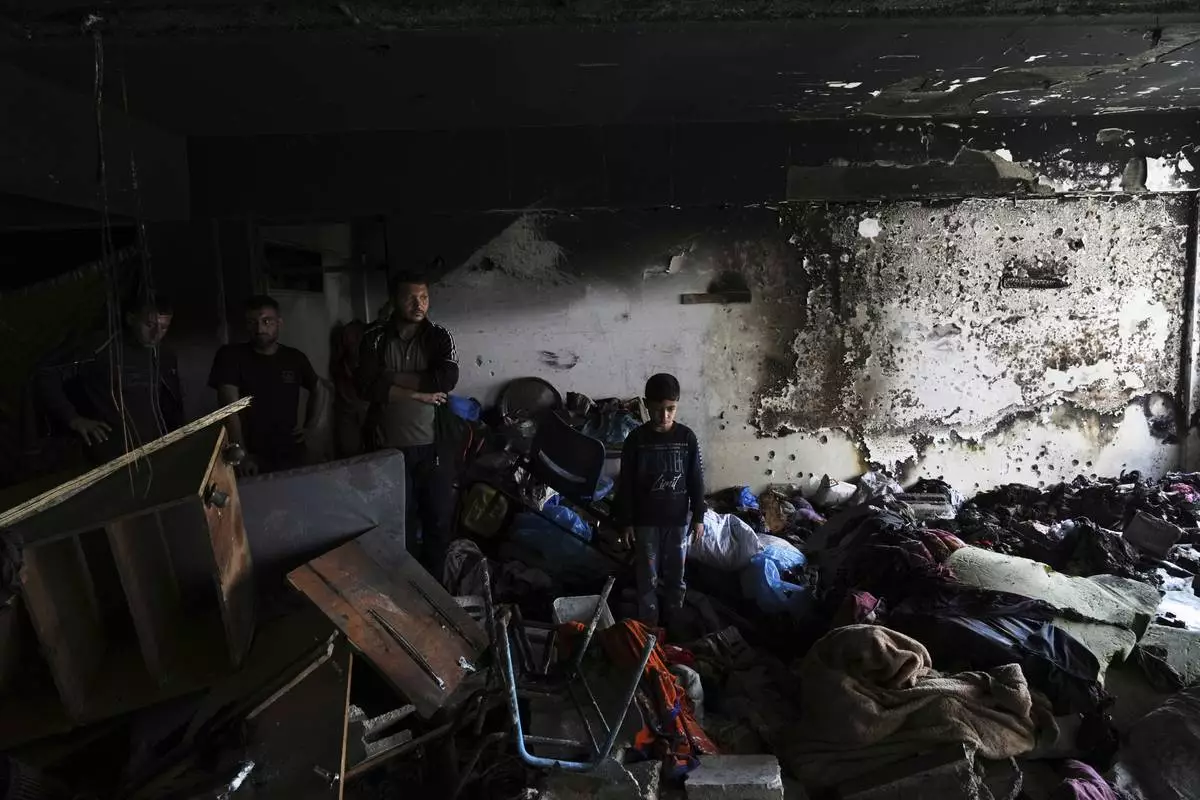
Palestinians inspect a UN building after it was hit by an Israeli strike, in Jabaliya, northern Gaza Strip on Wednesday, April 2, 2025. (AP Photo/Jehad Alshrafi)







































